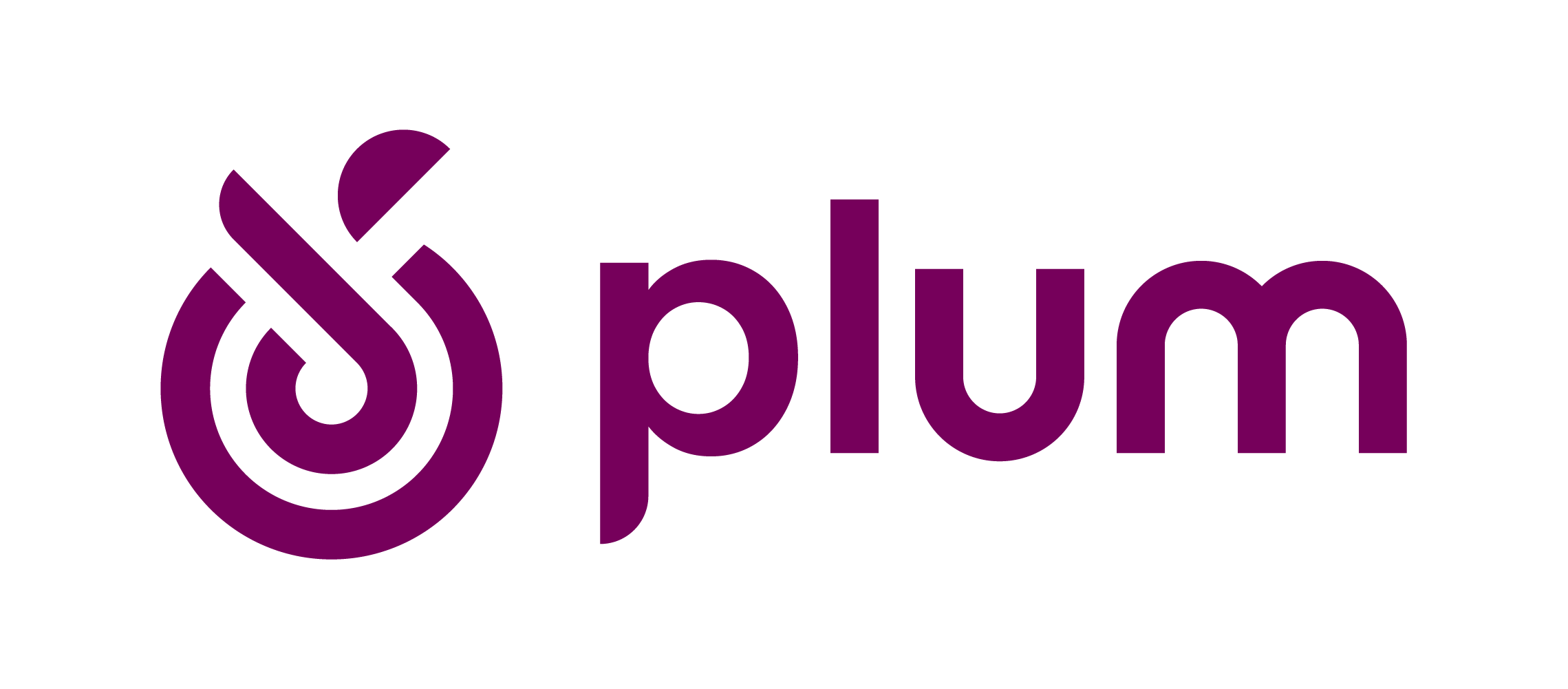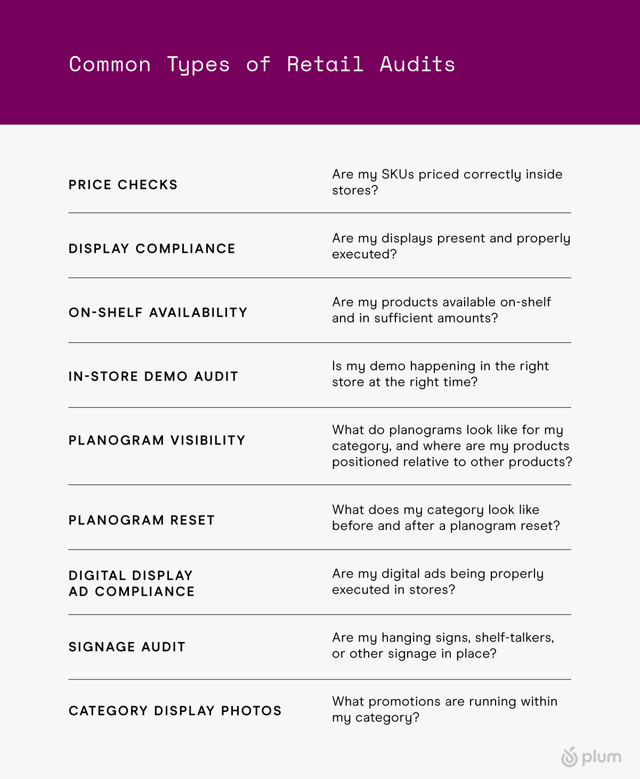
What is a Retail Audit? Everything a CPG Brand Needs to Know
Have you ever had a leak within the walls of your house? Sometimes the most costly and destructive problems are just out of sight.
But if you can see 'em, you can fix 'em. Before the damage gets out of hand.
That’s really the driving principle behind a retail audit.
For just a sec, think about all that goes into capturing in-store sales for a particular stock-keeping unit—whether it's candy bars, frozen meals, or air fresheners. There's so much we could say, but for now just focus on the four Ps of merchandising (and marketing):
- Product: By this we mean replenishment, or ensuring inventory is in the right place at the right time in the right quantities
- Place: Or space. Maximizing a SKU’s footprint inside a store, since more space often means more sales
- Price: Establishing a price point—relative to other products in the category—that will drive trial and purchase among shoppers
- Promotion: Using displays, signage, coupon dispensers, digital ads, and other POS materials to entice those shoppers into making a purchase
All four activities are crucial to growing a brand at-retail.
But now consider all that can go wrong—and, honestly, often does—in each area. As you can see below, there’s room for error in retail execution. Unfortunately, lots of it.
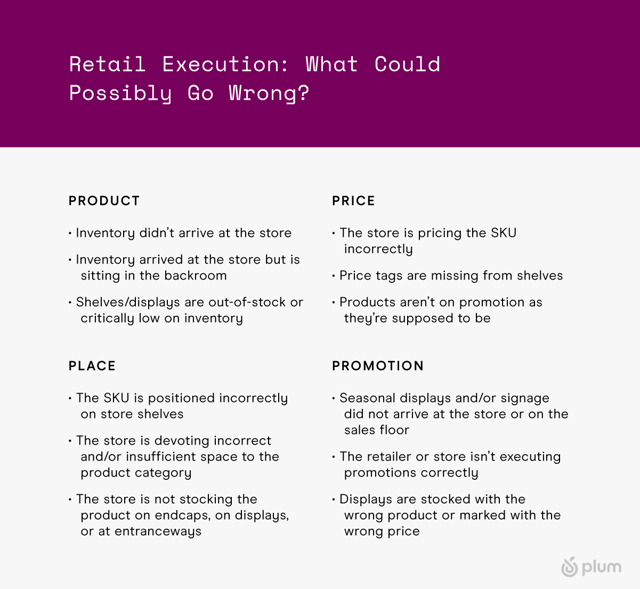
And appreciate that today, in the chainstore age, these problems might be limited to more than one or two stores. Problems with product, place, price, and promotion may be chain-wide—present across even thousands of stores.
Clearly, there’s a pressing need among CPG brands for a tool to ensure products are where they should be—in the right place, at the right price, under the right circumstances.
That tool is retail auditing. Mic drop.
What Every CPG Brand Needs to Know about Retail Auditing
Why are retail audits important?
How often should a retail audit take place?
What are the most common types of retail audits?
What are the major challenges in conducting a retail audit?
What is a retail audit?
While taking different forms, every retail audit is an evaluation of in-store conditions to determine whether retail partners or other parties are correctly and efficiently executing a brand’s retail program.
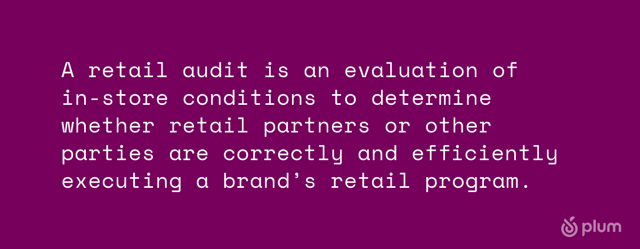
Maybe a CPG company negotiated a ridiculously great program with their retail buyers, and maybe their supply chains faithfully delivered their products to stores. But what happens now—in the retail execution phase—is much more difficult for brands to control; now they’re largely dependent on the retail partner doing their job—and doing it just right.
Here, however, distance becomes the enemy. With hundreds or thousands of miles between headquarters and their retail operations, how can a brand know if retailers and/or stores are stocking, displaying, pricing, and promoting their SKUs correctly?
Retail auditing bridges the gap between a brand’s headquarters and its far-flung retail operations, offering a direct line-of-sight into stores everywhere. So CPG companies know—and know that they know—their program is being executed correctly. That their retail execution is maximizing sales, not undermining them.
Why are retail audits important?
A retail audit, (read as: store, compliance, or merchandising audit) is a CPG company’s first and last line of defense against mistakes that could, ultimately, cost a brand millions of dollars in lost sales. Even seemingly small retail problems—an incorrect price, a missing display, a misplaced SKU—can be devastating when multiplied by thousands of stores.
At the end of the day, that’s why retail audits are important. But, there are many other benefits as well, as shown below.

Retail audits help brands avoid, fix, control, plan, propose, and learn. In short, to grow their brand at-retail by optimizing their in-store execution.
Yeah, you could say... all important things.
How often should a retail audit take place?
There’s no hard and fast rule about this. One rule-of-thumb is to audit your retail execution, particularly stock levels, planograms, prices, and promotions, on a quarterly basis.
Yet so much about this question ultimately hinges on:
- Your category (e.g., consumables, durables)
- Audit type (e.g., planogram, price)
- Occasion (e.g., seasonal, ongoing)
Consider, for example, planogram audits for a seasonal product. Maybe your brand has a lot riding on a particular gift box set performing well with holiday shoppers. At such times, a brand would be well-advised to conduct a planogram audit before and after the planogram “resets” as well as midway through the season to ensure the product is being executed correctly.
On the other hand, for planograms containing evergreen household consumables, the “right” auditing cadence could look way different.
But we know this much to be true: proactive approaches to retail auditing are generally better than reactive approaches. Here’s what both approaches might sound like:
- Reactive auditing: “Why is this SKU performing so poorly in stores? Could there be a problem? Shoot, we’d better do an audit.”
- Proactive auditing: “We 'can’t expect what we don’t inspect,' so let’s set up an ongoing audit around these parts of our retail execution.”
One (reactive) starts with a problem, while the other (proactive) keeps those pesky problems at bay—and so clearly has advantages.
Retail auditing is like so many preventative things in life—dental cleanings, termite inspections, and oil changes. Is it too assuming to say "A plum a day keeps the doctor away"?
But unlike dental cleanings, a retail audit can also uncover opportunities. Opportunities to increase sales.
And since retail auditing has become more affordable and programmable over the last decade, it makes sense to audit more often than less.
What are the most common types of retail audit?
Generally speaking, retail audits often focus on areas of retail execution like replenishment, prices, planograms, displays, and in-store promotions.
Here’s a quick snapshot of several auditing products, including price checks, display compliance, and on-shelf availability, to demonstrate the variety of retail audits available today.
See this page for examples of each audit below.
Ultimately, where there’s a retail audit, there’s a pressing retail question.
And there’s likely an audit designed to get an answer.
What are the major challenges in conducting a retail audit?
At this point, if you're reading along with us and you happen to be a CPG professional, you're tracking right along with us. Of course, retail audits are good. Even necessary, you'd say, to winning those coveted retail sales.
So what prevents brands from conducting in-store audits... or conducting them more often?
Let’s consider a few prevalent barriers to retail auditing:
(1) Speed
As mentioned, where there’s a retail audit, there’s a retail question. And CPG pros normally needed that answer, like, yesterday.
In the fast-moving world of CPG retail, questions often have a very short lifespan. If a brand representative can’t get a quick answer, they might forego the question (and audit) altogether.
(2) Coverage
Retailers today often have lots of stores. We did the research this morning for you...
- Walmart has 5,335 U.S. stores
- Kroger has 2,800 U.S. stores
- Target has 1,934 U.S. stores
So what does it mean if, say, five Walmart or Kroger stores have the right (or wrong) prices or displays or stock levels? For national brands, maybe very little.
After all, five stores is only a drop in the bucket for one of these giant retail chains. Consequently, brands often require auditing solutions that can provide visibility into thousands of stores, not just tens or even hundreds.
So, limited coverage may at times prevent brands from going full-throttle with their auditing program.
(3) Reliability
Like just about everything these days, not all auditing solutions are created equal.
Here are a few major differences:
- Personnel (e.g., sales team vs third-party merchandiser vs crowdsourcing)
- Technology (e.g., image recognition vs photo capture)
- Data capture (e.g., spreadsheets vs dedicated apps)
- Quality control (e.g., automatic vs manual)
Because no two retail auditing solutions are the same, you can expect varying degrees of quality in their deliverables. “Quality issues” are, thus, another challenge to retail auditing.
(4) Cost
Even if a CPG professional can make it past these three hurdles of auditing challenges, they may still have limited budgets to contend with. It's important for brands to get the most bang for their retail-execution buck—and some auditing solutions are more expensive than others.
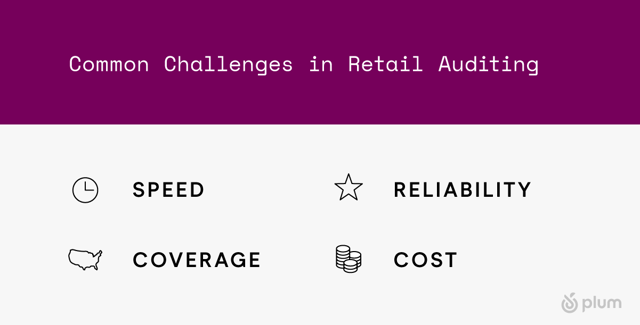
But here’s the good news: All four barriers are quickly becoming more surmountable.
The driving force? Technology.
Imagine a time when retail auditing looked like this: headquarters staff hopped on jetliners and visited stores across the country, walking up and down aisles making marks and taking notes about their various SKUs with a clipboard and pencil. Anyone remember those days? Let's call this traditional auditing.
Traditional auditing was relatively slow, unreliable, limited (to a narrow geographic footprint), and, most certainly, expensive. But technology has changed the game.
Consider, for example, one of our trusted solution providers: Field Agent. Field Agent’s auditing capabilities are built on a foundation of crowdsourcing and smartphone technology. Boiled down to the basics, Field Agent crowdsources the smartphones of over two million U.S.-based shoppers who have downloaded the app—sending them on auditing missions to check up on our clients’ in-store operations.
Consider how such a high-tech approach impacts the challenges above:
- Speed - Most Field Agent products can be launched, on a self-serve basis, in a matter of literal minutes and often start collecting auditing results within a few hours
- Coverage - With over two million app downloads, Field Agent auditors are spread across the country, practically anywhere brands are selling their products
- Reliability - Smartphones, unlike clipboards and spreadsheets, have GPS-tracking, time-stamping, and photo-taking capabilities. Just a couple of ways tech can enhance the reliability of auditing results
- Cost - The combo of technology and crowdsourcing creates cost-savings, through their greater efficiency, that Field Agent can pass along to clients
So while these barriers have not gone away, neither are they as daunting as they once were. Thanks, technology.
For CPG gurus, however, it remains important to assess audit providers in light of speed, coverage, reliability, and cost.
Launch Your Own Retail Audit in Minutes
Designed by CPG professionals for CPG professionals, our Plum Marketplace is jam packed with fast, far-reaching, reliable, and cost-effective auditing solutions. You can launch a price check, display compliance audit, or another retail audit with just a few clicks, in just a few minutes, for just a few dollars. Click below to explore our auditing solutions.
